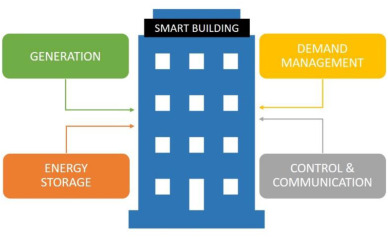A simple definition of an Energy Management System is a system to control and monitor energy-consuming devices, which may include heating and cooling equipment, fans, pumps, dampers, and lighting. Energy management systems can also be used to control refrigeration equipment, industrial processes, or other systems. For purposes of this blog, we’ll focus on HVAC and lighting since they are the most relevant for our client’s commercial and industrial facilities.
- Commercial & Industrial Asset Owners can reduce energy expenses greatly with an EMS
Generally, an EMS consists of three necessary elements: sensors will measure things like temperature, pressure, and light levels which are used to initiate responses by the system. Controllers will compare a signal received from a sensor to the desired set point and send out a signal to a control device for action. The controlled devices are the equipment that receives the signals from the controllers, such as a fan, a pump, a damper, a light switch, etc. In larger buildings and more complicated systems, there’s usually also a computer that provides a user interface that pulls all the information together for the building operator. Energy management systems can also be known as building management systems, building automation systems, or energy management control systems.
Energy management systems have evolved in complexity over time. The most basic form of energy management consists of a simple time clock and thermostat. Many times these systems are still the best choice for control in certain buildings today. Early centralized systems used pneumatic controls, and some of the systems can still be found in older buildings. New energy management systems use direct digital control or DDC. DDC systems can use proprietary software, or they can utilize open protocol standards that allow components from different systems to work together.
The building operators can use an energy management system for different purposes. The main purpose is generally to ensure occupant comfort. Beyond that, systems can be used to operateequipment properly, ensure proper maintenance, maintain safety, and of course to generate energy savings. In fact, many energy management systems pay for themselves through the electric utility savings they generate!
The first two are the most important for energy savings:
- Energy management systems can manage the length of time that equipment uses energy, usually with very flexible scheduling options.
- Users can often configure multiple start and stop times for each piece of equipment for each day of the week, with exceptions being programmed for holidays or other changes to technical
operations.
Energy management systems can also manage the demand or the need for energy-using set points for various sensors in the system, including space temperatures, pressure, humidity, flow rate, light levels, carbon dioxide, etc. Monitoring and trending can also be used to generate energy savings, but a little bit more indirectly. Energy management systems have the ability to track the space condition as monitored by the sensors, or the status of the equipment operation. This information can then be used to understand how the equipment is operating, and then come up with strategies to improve that operation. At BCSC, we work with a number of nationwide energy management system providers and recommend implementing an energy management system in conjunction with your solar and battery storage project. After all, it is always our goal to reduce (energy consumption), and then produce (clean energy)!
Contact Us!
Get your turnkey energy management system proposal by e-mailing us your last 12 months’ electric bills: info@beachcitiessolarconsulting.com


